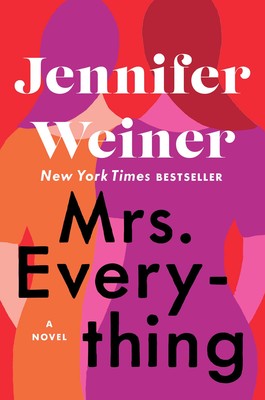September 4, 2019
Trick Mirror, by Jia Tolentino
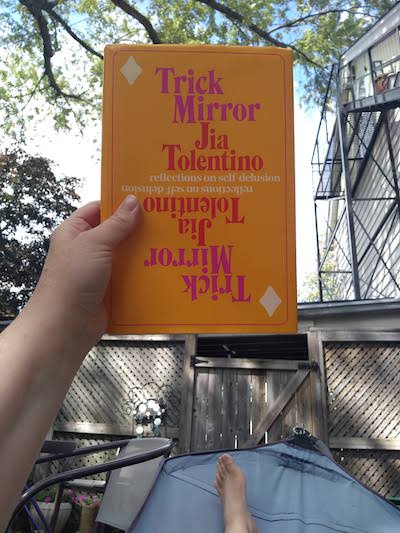
I don’t think I’ll ever be ready to write a post about Jia Tolentino’s essay collection Trick Mirror, but I was set to do some preparatory work before I did. Because these aren’t essays that I’m finished with yet, or completely understand properly. These aren’t blog posts or hot takes that have been churned into book—these are essays 40-50 pages long, and one concludes with, “I wish I had known…that the story didn’t need to be clean, and it didn’t need to be satisfying; that, in fact, it would never be clean or satisfying, and once I realized that, I would be able to see what was true.”
I am still trying to puzzle my way through her incredible “The Cult of the Difficult Women,” which explores the way that Daring Girls pop-feminism becomes weaponized for anti-feminist purposes—”But when the case for a woman’s worth is built partly on the unfairness of what’s levelled at her, things get slippery…” My OOF moment in “Pure Heroines,” about literary girlhoods and the limits of literary womanhood, rich for me with familiar points of reference, when she writes, “You’ll have noticed—surely, you’ll have noticed, though I don’t want to be too generous—that all the characters in this essay are white and straight.”
These essays are trickier than most others I’ve ever encountered, pulling away and pushing on just when you think they’re settled, and resisting tidiness, easiness. So that the reader comes away with their mind still spinning, work to be done. Tolentino offers no conclusions, resolutions. She is not going to do the work for you.
I read a review recently that focussed on the bleakness and despair in these essays, works that make connections between the Fyre Festival and the 2008 financial crisis (and GirlBosses) and a culture of scamming: “There are fewer and fewer options for a person to survive in this ecosystem in a thoroughly defensible way.”
But bleakness and despair was not my takeaway from Trick Mirror, the title a statement on the nature of true and reality, delusion and self-delusion. How do you know when what you see, or what you are, is real? And just when you think you’ve got it settled, it’s gone and changed again. And bleakness and despair was not my takeaway because it took me almost two weeks to finally buy this book, which was sold out at every bookstore I showed up at. And if the demand is so high for these rich and erudite works, essays that aren’t going to fucking let you get away with it or get away with anything… The way I feel every time I see the way that someone (usually Ali Smith) has made something so artful for these torrid time we’re living in—oddly hopeful, even. Not all yet has been lost.
August 27, 2019
The Need, by Helen Phillips
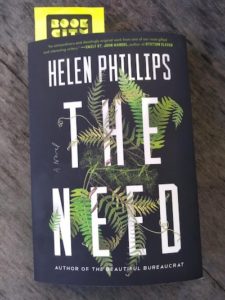
“She and David had a running joke about how they both feared their kids at night the same way that, as children, they’d feared monsters under the bed. Beasts that would rise up from the side of your bed, seize you with sharp nails and demand things of you.”
I’ve been hearing things in the night for my entire life, the sound of footsteps, or maybe the house is just settling, or the sound of the wind outside. What was that? But it’s only since I’ve become a parent that I actually see things, that I awake from sleep with the uncanny feeling of someone standing over me, and I open my eyes and there they are, my worst fears confirmed. (And the fear, I mean, is in addition to the practical matters, that these nighttime visits are generally a harbinger of the fact that I’ll have to clean up puke.)
In her novel, The Need, Helen Phillips zeroes right on this kind of anxiety (albeit regarding an even more sinister nighttime interloper) in the book’s first three sentences: “She crouched in front of the mirror in the dark, clinging to them. The baby in her right arm, the child in her left./ There were footsteps in the other room…”
Molly’s husband, a musician, is away on tour, and she’s just relieved the babysitter. She’s the primary breadwinner in the family, a paleobotonist who works at a site that’s turning up baffling specimens: plant fossils that don’t seem to related to any other living thing on earth, an Coca Cola bottle whose logo slants backward, a Bible that addresses God as “her” and “she.”
Something is askew, but also everything is askew, because Molly has a baby and a toddler, which means she hasn’t had a proper night’s sleep in years, and her hours are consumed by her children’s near insatiable needs and demands upon her. So there is something metaphorical about the otherworldliness Molly is experiencing at work, and we’re to doubt her perceptions—are there footsteps at all?
But the footsteps are real, and the stranger in the other room wearing a deer mask has a bizarre awareness of Molly’s family’s life and their rhythms—and the reality behind this situation turns out to be nothing like what you’ve expected, and it continues to be questionable how much the reader can understand this as “reality” at all.
This is a novel in which everything is true and possible, and nothing is; where a child’s birth and existence contains the possibility of their death; where doubleness is a solution and a nightmare; where the cessation of what seems unbearable is unsurvivable; and where the figurative and literal do battle, as do the fantastic and realistic; and ambivalence has its every nook, cranny and sub-basement explored.
This novel starts off terrifying, and the way Phillips sustains that suspense (moving back and forth between two timelines, plot, twists and pacing) is astoundingly well done. Though I will admit that by the time my biggest questions had been answered (which only invited plenty more questions still, of course) I was less enveloped by the plot—though probably for the best, if we’re thinking about my blood pressure.
All this with a novel that articulates the minutiae of daily life with children like nothing I’ve ever read before, a twisted and brilliant version of Rachel Cusk’s A Life’s Work.
And then the ending—so dark and banal at once. So subtle that you might even miss it, but the subtlety—of the violence, the brutality, that you could miss it—is the point. The Need is a fast read, but it’s haunting.
August 22, 2019
Watermark, by Christy Ann Conlin
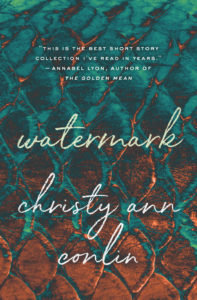
In order for a short story collection to really work for me these days, it’s got to be a book, which is not a popular opinion in short story circles, I realize. And while in other seasons of my life, I’ve had time for those collections that must be measured out (and I think I’ve even written blog posts in ode to them), right now I’m measuring my life in towers of books I’ve read, as compared to the even more colossal towers of ones I’ve got to get around to still—so I require momentum, some kind of arc, stories that complement each other and provide me with a very good reason to power through.
And Christy Ann Conlin’s latest book Watermark fits the bill exactly, which was why I was so happy to be devouring it last weekend. Most of the stories are set in Nova Scotia’s Annapolis Valley, and even the stories that aren’t are about characters who cannot become untethered from the place, no matter how they try. There are a few links between the stories, though they’re not completely overt. And also links to Conlin’s acclaimed first novel, Heave, which was published in 2002.
But primarily, this collection is drawn together by by characters who are witchy women, or supposed to be so. Women who are dangerous, wayward, and refusing to conform…and indeed a writer can cast her net wide in that area, and still come up with remarkable breadth, as Conlin does here.
Ragey mothers, rebellious daughters, reluctant wives, and furious sisters populate the stories in Watermark. My one criticism of the collection is a couple of stories with way too much expository dialogue. But apart from that, the book is terrific. The first story that stunned me was “Occlusion,” about a woman with a messy life undergoing an examination for lumps in her breasts—and it intermeshes with other storylines about still birth, infertility, friendship, sisterhood, rivalries, and the possibilities of a family curse. (What kind of thing is destiny?) I also loved “Back Fat,” about a boat, a bad marriage, and an old friend who sticks around like a bad smell or the devil on your shoulder. “Desire Lines” is about a woman whose father fashioned himself as a mystic and who grew up as part of his commune—until a terrible tragedy severed her from him forever. But for better or for worse? “Beyond All Things is the Sea” begins, “Birdie says to go tits to the wind./ And I am going tits to the wind.” A rollicking, jilting (in more than one sense of the word) story that takes place in a van that is a getaway car as Seraphina is driven away by her two best friends from what was nearly her wedding—and I think this was the launch point for Heave.
There is death and murder, and accidents that may not have been accidents, or maybe the moral of these stories is that there is no such thing as an accident at all. Instead, there is purpose, precision, and an incredible haunting darkness, all of which are the reasons why Watermark is such pleasure to read from cover to cover.
August 12, 2019
Crime Fiction Round-Up
One Small Sacrifice, by Hilary Davidson
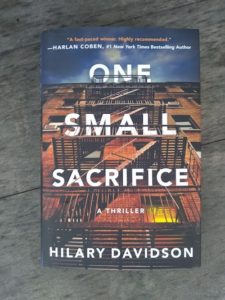
It took a bit of time for Hilary Davidson’s latest to grow on me, mostly because the novel begins after a lot of the story has already taken place. War photographer Alex Traynor escaped conviction after the death of his friend a year before, but Detective Sheryn Sterling has had her eye on him—and when his fiancee goes missing, Sterling is desperate to find her and finally get this dangerous character off the streets where he belongs. But of course, the reality of the situation turns out not so straightforward after all, as sections of the book from the point of view of Alex and his fiancee make clear. Even more difficult, Alex suffers from the effects of PTSD and isn’t entirely sure he can trust himself after suffering from blackouts. But once the novel got going, I was totally hooked, and there were plenty of twists I never saw coming. New York City also makes for a spectacular setting (that cover, right?) and Davidson evokes it so well. I really loved this one.
*
A Dance of Cranes, by Steve Burrows
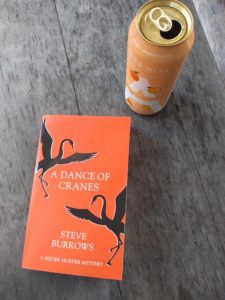
Can you believe I’ve been reading the Birder Murder mystery series for six books now? Never a disappointment, even if sometimes plot lines strain for credulity. (Shocking for a birdwatching detective series, right??) But I continue to adore these books, this one which starts off with Inspector Domenic Jejeune back in Canada and split with his partner Lindy (for her safety, of course, though he doesn’t bother to tell her about that) but now Domenic’s brother has gone missing in a vast and remote park in Canada’s north (obviously, there are whooping cranes involved) and it’s up to Domenic to rescue him, risking his life in the process. All the while back in England, Lindy’s life continues to be in danger, but not for the reason everybody thinks it is (and obviously, there are cranes involved, though not necessarily whooping) and will romance finally blossom between Detectives Lauren Salter and Danny Maik? A fabulous instalment in a series that is reliably delightful.
*
A Better Man, by Louise Penny
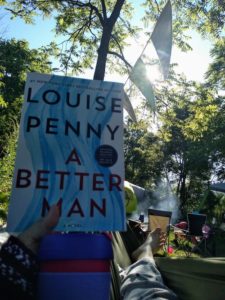
And speaking of reliable, the latest Inspector Gamache novel is a summer highlight for me every year, even through credulity often suffers the same straining. But reading Louise Penny while camping is my favourite thing, and I’ve been doing it for years now, for so long that I no longer believe that Gamache carries the scent of sandalwood, as the narrative asserts, but instead: he smells like campfire smoke. A Better Man stays close to Three Pines—rivers are raging and spring floods are high, putting the province of Quebec in peril. And then a woman goes missing, and her abusive husband just might get away with the crime. Gamache has returned to Head of Homicide after a demotion and is serving with his son-in-law, Jean-Guy, for one more case before Jean-Guy and family begin a new life in Paris. The personal and professional remain interwoven in this story, which was everything I look for in a Louise Penny novel. Reading it is truly a pleasure.
August 5, 2019
Keeping Blogging Weird
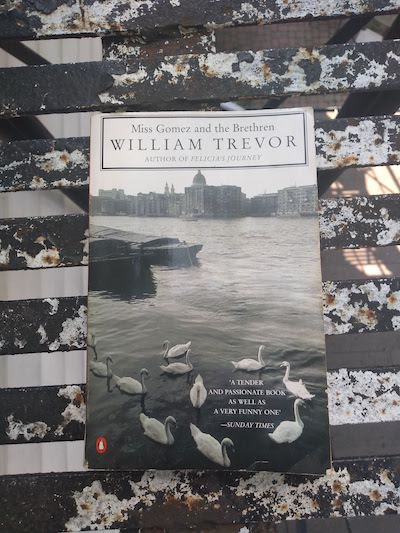
In the spring, @hkpmcgregor recorded an episode of Secret Feminist Agenda about “Keep Podcasting Weird,” and I’ve thought about the episode a lot in relation to blogging and book blogging. I had been blogging about books for awhile when publishers started sending me review copies in 2007ish, and while I was grateful for their attention and consideration, I lament now what it did to my blog. Because it turned my blog into a blog that looked like everyone else’s, and at the time I even thought that meant I was finally doing it right. But what gets lost—attention to obscure novels, my own unique perspective, the indulgence of my own curious avenues. It’s also just not as interesting to be blogging about exactly the same books that everyone else is, and what exactly is the point of this pursuit, beyond contributing to online homogenization.
I’d started blogging about books while I was a graduate student, so I’d been writing about Virginia Woolf and Victorian entomologists, and I was obsessed with the works of Margaret Drabble and Laurie Colwin…and then all of sudden here I was reviewing the new Ian McEwan. Yawn.
From my new online blogging course, Find Your Blogging Spark
More than ten years on, I’ve learned the virtues of keeping it weird, who wins when we do (hint: it’s everyone), and what a more interesting place is the blogosphere and #bookstagram when we make space for novels purchased for a dime at a provincial park camp store. Books you decide to spend that dime on because of a description that begins with, “Only the pub and the pet shop are still inhabited in the boarded-up wasteland of Crow Street Southwest London…”
I spent much of this long weekend reading Miss Gomez and the Brethren, an early novel by William Trevor, whom I’ve never read before, and the novel reminded me of Muriel Spark, that curious midcentury mix of slightly old fashioned and shockingly sly and subversive at once, with an outsider’s view of Englishness.
I absolutely loved it, and have been thinking a lot about serendipity, partly because the book is about just that (although in a darker and less whimsical sense) and also because of the odds of this book and I finding each other, the most perfect literary match. Whoever left this book—which I’d never even heard of—in the camp store so that I would find it because we’d ducked in to get out of a thunderstorm, lingering over ice cream cones to avoid going out into the rain. Someone left it and I happened to find it, picking it up because William Trevor’s on my long list of authors I’ve been meaning to get around to reading, and here was one of his books in my hands, the kind of summer reading magic that is impossible to manufacture, but I’ve been grateful to be a beneficiary, and have this book be part of a wonderful long weekend.
August 2, 2019
Mrs. Everything, by Jennifer Weiner
I had an oddly optimistic revelation about the world the other day—odd, because I haven’t had an optimistic revelation about the world for at least four years—which was that when people look back on the literature published in the second half of this decade, they’re going to be thinking, “Good gracious, the Patriarchy (RIP) on its last legs must have been quaking in its ugly boots.”
Because the books are so feminist, and furious, confronting racism and violence against women. Fiction and nonfiction, commercial and literary—I promise I haven’t been even deliberately seeking them out. But almost every book I’ve picked up this year, and certainly every one that I have loved, has been staring the patriarchy in the face and having none of it. Refusing to submit, to be polite, to keep things uncomplicated, to tolerate the status quo.
And in 25 years—after the current US president has been found dead on a toilet, the stupid red hats have disintegrated (cheap production will do that), and a few remaining rat-men have built an all-male colony out in the ocean on an island constructed from millions of copies of 12 Rules For Life (I would LOVE to know the number of people who bought that book versus number of people who finished it; is that why it keeps selling? Because the reader hopes a different copy might prove worthy of their attention?)—these books will be what remains of this time, the culture we made.
It’s sort of like the illusion I once bought as a young person that the 1960s was only groovy and folk songs, instead of political assassinations, endless war, and racial violence. You know the expression, “You had to be there.” In this case, it’s kind of the opposite. It’s even better if you weren’t.
And this is the gist of Jennifer Weiner’s latest novel Mrs. Everything, her thirteenth novel and her tour de force, a novel that reminded me of recent work by Meg Wolitzer and Lauren Groff. My one criticism that it started out unsteady, the story of a family in the 1950s whose American Dream is coming true, a mother and father and two daughters who’ve just moved into red brick house in Detroit. The characters are a bit stock at this point, the good girl and the bad girl, their disapproving mother, some manufactured drama…but then the novel starts going and it never stops.
What I love best about this novel is what I love best about any narrative that features more than one woman (which is the only kind of narrative I love at all, to be honest). That the women in the book are not foils, that their characters and narrative development is sufficiently complicated, and that their relationship is as much supportive as it is fraught. And such is the way with Jo and Bethie Kauffman, the two sisters who grow up in that house in Detroit. One is posed to be the good girl and the other is the problem, and then fate intervenes and neither one ends up on the trajectory that she, the reader, or anyone else imagines for her. Jo will become a suburban housewife, Bethie the counterculture rebel, but neither archetype is the whole story, and the whole story is mostly that there is no right way to be a woman. We live in a society that’s going to mess with each and every one of us.
The novel takes the sisters from the 1950s through to the present day, and beyond, and its fabulous momentum builds as it goes. The sisters come together, are pulled apart, face heartbreak and trauma, keep going, keep learning and growing wiser all the time. This is a story of women, and civil rights, and the rise of LGBTQ rights as well.
The constants? Weight. It’s not a theme of the book, but it’s always in the background, as its always in the background (maybe not so far back) of the lives of almost every women I know. Feeling fat when you’re not, and then actually being fat—is it not remarkable that women are able to feel badly about themselves no matter what their size? It’s a fascinating narrative strand in the book. As is the idea of mothers wanting something different and better for their daughters than what they themselves have had to go through, but the thing about daughters (who are women, who are people) is that they don’t always want to dream the dreams their parents dream for them, and they have to learn from their own mistakes, and also none of us want to entirely believe that we’ll be subject to the same rules our mothers were. We’ll do it different, this time, and we do, but some things stay the same, as Mrs. Everything serves to underline.
As Michele Landsberg explains in her book Writing the Revolution: “Because our history is constantly overwritten and blanked out…., we are always reinventing the wheel when we fight for equality.”
But I would like to believe there is something different about the current moment we’re in, when women are finally courageous enough to call out discrimination, abuse and violence, to finally call things by their names. Because in not being able to do so before, were we blanking out our own history, our own experiences? Doing the work of the Patriarchy for it, but no longer. I hope.
Mrs. Everything misses absolutely nothing.
July 24, 2019
Even Weirder Than Before, by Susie Taylor

There is a sweep to Susie Taylor’s debut novel, Even Weirder Than Before, each scene written in the present tense and turning into the other so seamlessly. Daisy Radcliffe—our protagonist, who we meet in her thirteenth year at precisely the moment that her father has left their family to take up with one of his graduate students—is never in transit, but rather Taylor has her narrative move from scene to scene and with such smoothness, like a film reel. Like the way that adolescence goes, I suppose, one life changing moment leading right into another without a great deal of forethought.
I really loved this book, which takes Daisy through her teen years, first kisses and first boyfriends, trying to find herself while her family has broken down, and the ebb and flow of friendship. Adolescence is a terrain that many authors have mined before, but Taylor’s approach is fresh and interesting, and all her characters are delivered complexity where lesser authors might have served up tropes (ie the depressed divorced middle aged woman; the deadbeat boyfriend). It doesn’t have quite the same level of absurdity, but Taylor’s narrative recalled Sue Townsend’s Adrian Mole Diaries for me, and also Brian Francis’s debut novel Fruit, both books light on the surface but rich with subtext, which Even Weirder Than Before is exactly.
It’s a queer coming-of-age novel, but its politics is a trick up its sleeve, the very best move saved until the novel’s final sentence. But in the pages before it, we see Daisy learning about her own power as a woman and lack of it, how her mother is messed by the patriarchy, and how the characters in the book, male and female both, respond to the shootings at Montreal’s Ecole Polytechnique, a tragedy that doesn’t appear to touch Daisy’s world directly, and she’ll be older before she really understands. With a subtle hand, Taylor has written a political book that’s also at home in its bright and appealing pink cover—and it’s absolutely a joy to behold.
July 19, 2019
Your Life is Mine, by Nathan Ripley

In two days, I tore through Your Life is Mine, Nathan Ripley’s second novel, (his debut was Find You in the Dark), a book that got richer and deeper as its complex plot progressed. And isn’t that rare? A thriller whose meaning intensifies as the reader gets closer to the resolution?
I loved it.
The protagonist is Blanche Potter, a documentary filmmaker who’s just beginning to enjoy some success with a true crime feature, but she just can’t escape the notorious true crime in her own history, no matter than it was years before and she’s changed her name, and no one (except her best friend Jaya) knows who Blanche really is. That she’s actually the daughter of cult leader Chuck Varner who died after a killing spree that Blanche was witness to as a young child. And Blanche would not be surprised if her father still has followers out in the world intent on carrying on his violent mission, because she knows from experience—she herself spent much of her life under by his spell.
Which is why the news of her mother’s murder delivers Blanche some relief at first—one less tie to Chuck Varner, because Blanche’s mother had never shed her devotion to the man or his message, and getting over having two such messed up parents has been the goal of Blanche’s adult life. She even appears to be succeeding at it…except the news of her mother’s death has been delivered via an aspiring writer who knows too much and wants Blanche to share her story. And he also reports that Blanche’s mother’s murder was a random act, but Blanche knows there’s never been anything random about her tortured family life.
And so she returns to the scene of the crime, which is also the scene of her childhood, to find out who really killed her mother, and if the killer is likely to strike again. But is the whole thing a trap? It’s hard to tell who can be trusted, least of all Blanche herself who has buried years of trauma which is now returning to the surface, threatening to upset the careful arrangement of her present, and she could even end up dead.
The narrative moves between Blanche’s perspective, excerpts from a true crime book about her father’s legacy, and other secondary characters whose roles in the story take a while to become clear. There’s also a dodgy police officer, the sketchy guy who runs the trailer park where Blanche’s mother lived, and the aspiring writer—what are their connections to Chuck Varner? Is Blanche just being paranoid? And what is the most terrible part of her story, the part she has not yet told to anyone?
The novel begins with a broad canvas, but the story gets narrower and narrower as it gets closer to the climax, and doesn’t rely on all the usual tropes for this to work. One of my favourite characters in the book was the utterly effective police officer who comes equipped with a dose of humility, and actually listens to the protagonist—have we ever seen him in fiction before? And underlying the impressively crafted plots are all kinds of ideas about race and class, and gun control, cultism, misogyny and more. The story never stops being interesting, even as the pages are flying along.
July 16, 2019
Summer Reads
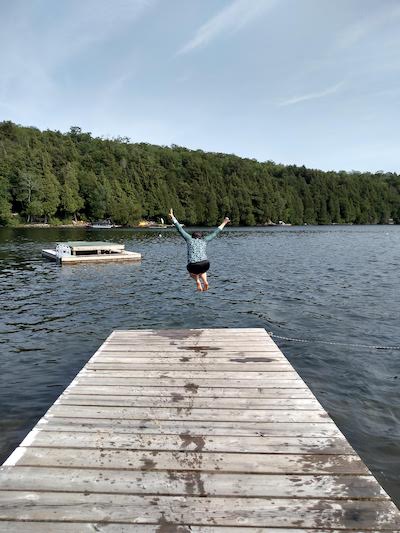
Last week was splendid, all the time in the world for swimming, reading, fun with friends, and board games, and chips and butter tarts. We couldn’t have asked for better weather or company, and it was wonderful to return to this lovely lakeside spot that we’ve been enjoying for the past four years and to be reunited with some of our favourite people. Of course, what most distinguishes a perfect holiday for me is that I got all the books read.
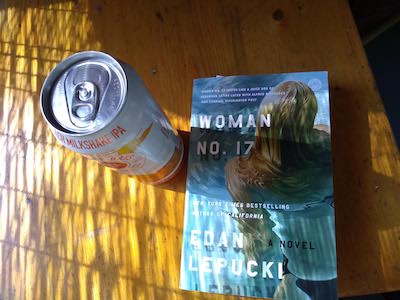
My first book was Woman No. 17, by Edan Lepucki, co-host of the Mom Rage Podcast, which I’ve become obsessed with in the last few months. And it was really good, so different, California-lit that put me in mind of Joan Didion or Rachel Kushner. Fucked-up women and what it means to be an artist, and examining motherhood from a fascinating angle—I was really interested in reading how the novel fed into Lepucki’s other projects (both the podcast and also Mothers Before). It was moody and atmospheric, and incredibly interesting. I loved it.
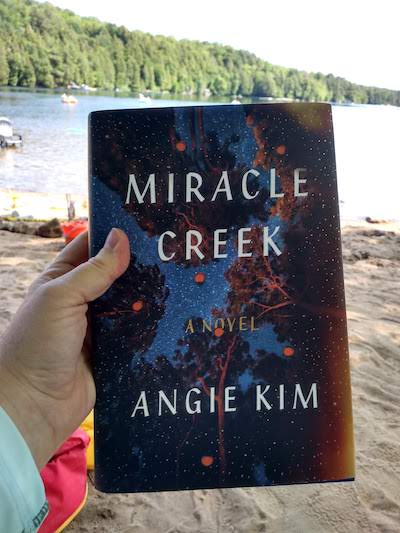
Next up was Miracle Creek, by Angie Kim, a courtroom drama by a lawyer-turned-novelist. An oxygen chamber—designed to treat such things as autism symptoms and infertility—explodes, and two people are dead, and everybody has a secret to hide. Did the mother of a young boy with autism kill her son intentionally? The machine’s owner, a recent immigrant from Korea, is not telling the whole truth either, and the novel is pretty riveting as all the pieces come together. Another book, like Lepucki’s, about motherhood and its demands on those whose children have special needs. Plot-wise, the book is excellent, although I yearned for a bit more subtlety (the last chapter is way too explainy) but I like my summer reading with a hook, so this was fine.
*
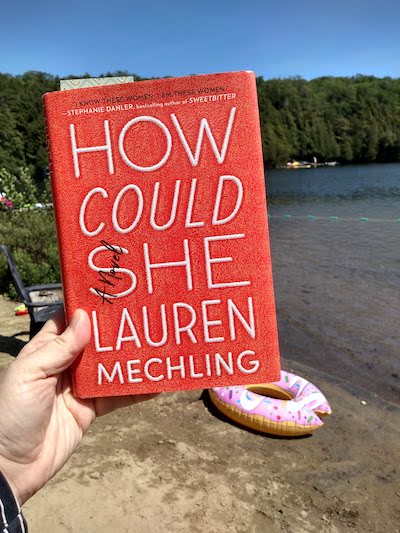
I read about How Could She, by Lauren Mechling, in Vanity Fair, which has far too little books coverage in it lately for my liking, and here was a book about female friendship that was partly set in Toronto, so I was most intrigued. It’s about a woman in her late 30s who wants to kickstart her life by moving to Manhattan, where two good friends—one an artist it-girl and the other a new mother—are well established in their lives. On the surface, the book seems light and frothy and somewhat untidy as a narrative, plus there were too many details about Toronto that were all wrong (such as, tragically, we don’t have a Shake Shack), but the whole thing came together really satisfyingly for me, and Mechling really finely articulated the weird and prickly nuance of friendship and its dynamics.
*
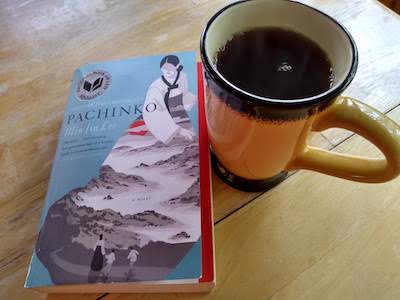
I’ve been meaning to read Pachinko for ages, and I’m perhaps the last human being on earth to get around to it. I’ve never heard anything but massive praise for this novel, a sweeping historical narrative about Koreans in Japan. And perhaps I’d been putting it off and putting it off because “sweeping historical narratives” are just not my thing, but I am glad I finally read this one, a five hundred page novel I read in a day. It was compelling in itself, but extra for me because I used to live in Japan and know that the historic prejudice against Koreans is not only historic. And it was fascinating to have a window about Japanese history that I haven’t seen before. It was an emotional and really interesting read.
*
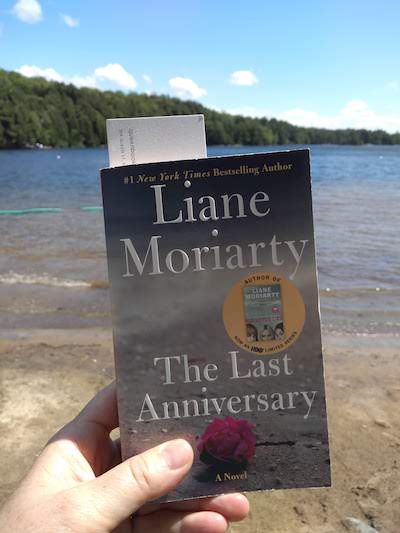
The opposite of a sweeping historical narrative is Liane Moriarty’s The Last Anniversary, which was a little bit stupid, but it was her second novel and I bought it for $8 at the drug store, so what was I expecting? It was terrific fun—family secrets, maybe murder, so much humour, and a map at the beginning!—and came together in such a smart way that foreshadows Moriarty’s eventual strength as a novelist. I also just really love mass market paperbacks and that you can buy novels at the drug store.
*
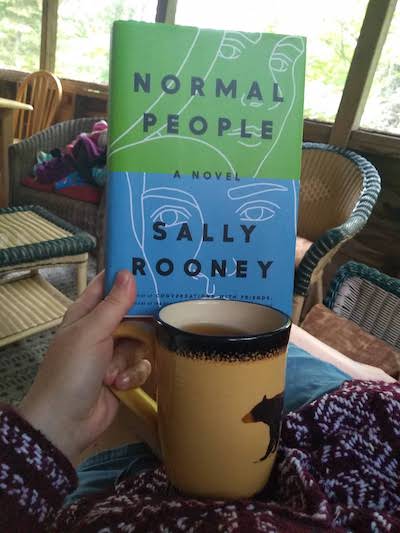
Not stupid at all was Sally Rooney’s second novel, Normal People, a novel whose hype was so amped that I almost resented buying the book, as though I didn’t have a choice in the matter. I’d read Conversations With Friends and liked it well enough, but had been led to expect way more from it than it actually delivered (and I thought it was kind of annoying). I bought Normal People after hearing Sally Rooney on the radio, and in hardcover even, but it was worth every penny. About a mismatched relationship between an outcast girl from a wealthy family and the popular boy whose mother is their cleaner, and what they find in each other and what they take from each other, and the dynamic is never static. Nothing is in this coming-of-age tale of love and friendship, a sad and beautiful heartbreaking story that was both familiar and strange at once. It was everything they said it would be.
*
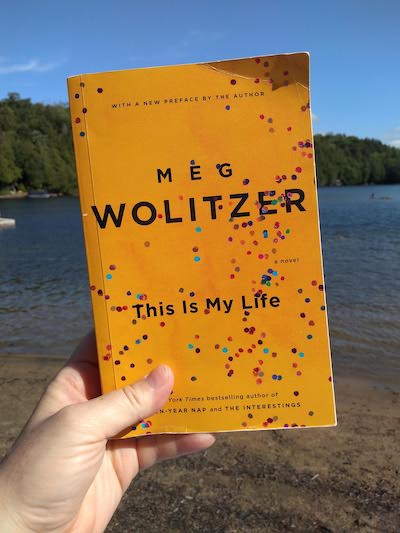
I read Normal People in a morning on our last day, when it was cool and grey and all I wanted to do was wear sweaters and read on the porch, but then the sun came out and we went back to the beach, and I got to dig in to This is My Life, from Meg Wolitzer’s back catalogue, which I bought at Books Are Magic in Brooklyn in May. And it was a really wonderful book. Flawed as a novel, as Wolitzer admits in her preface to this 2013 edition, but there were paragraphs in it that made me gasp with recognition, so perfectly articulated. It’s interesting to see what Wolitzer was up to so close to the beginning of her career, and I really loved this one. Definitely worth a read (and it was made into a movie in 1992, Nora Ephron’s directorial debut, although it looks like the movie version of the story was very different).
July 3, 2019
Molly of the Mall, by Heidi L.M. Jacobs
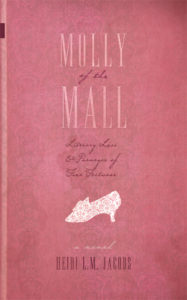
I am positively besotted by Heidi L.M. Jacobs’ debut novel, Molly of the Mall, which I kind of suspect was written just for me, a 1990s coming-of-age tale of a young woman who aspires to be an authoress and works at a mall. But not just any mall—the West Edmonton Mall, with its peacocks and water park, as far from Jane Austen as a mall can possibly be. A novel that is a teeny bit Bridget Jones’ Diary, if Bridget happened to work at a shoe store, and a whole lot of a Caitlin Moran-esque tale of how to build a girl, except instead of coming from a working class family in Wolverhampton, Molly’s the youngest daughter of a pair of academics, which can similarly render a person a misfit.
I loved this novel.
It takes place over the course of a year as Molly spends a summer working Le Petit Chou Shoe Shop (big on up-selling polish and sprays) and then going back to school for the third year of her English studies, feeling out of her depth in academia, aspiring to write a Jane Austenesque novel set on the Canadian prairies, and (naturally) wondering about love. There are several contenders for her male romantic lead, including a childhood friend who’s in her English class, her sister’s old boyfriend, and a mysterious man at the mall who she meets in the Penguin Classics section of the bookstore.
This is not a novel that anybody would ever call taut—but let’s not hold that against it. Instead of taut, this novel is a trove of delights, including a Jane Austen-inspired mix tape (side 2 is Mr. Darcy’s, and includes Chicago’s “Hard to Say I’m Sorry”); fragments of Molly’s ridiculous school assignments; passionate thoughts on Oasis and the Gallagher brothers (and an amazing passage on the first time she hears “Wonder Wall”; a fabulous plot thread on Molly’s determination to reclaim the works of James McIntyre, Canada’s cheese poet; and the part when her manager discovers she’s plotting her novel on a boring shift at the shoe store, instead of building polish displays, and she concocts a falsehood about writing a fan letter to Roy Orbison (“After an awkward silence, Tim looked at me and said, ‘You know he’s dead, right?’ I looked at the floor and nodded. I whispered, ‘It’s still too soon. I don’t want to talk about it.”)
If none of this sounds remotely appealing, then I am not even going to try to convince you. Molly of the Mall may not be for everyone. But if you came of age in the 1990s, worked in a shopping mall, longed for a literary life, ever felt a bit weird about your dad’s devotion to Robbie Burns, dreamed of a romance that was swoon-worthy, felt confused in university English classes, and let 19th century novels play perhaps too great a role in informing your perspective on…everything—then you will not be sorry. It’s also a really beautiful love letter to Edmonton.
Read this book.
